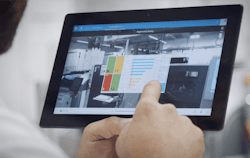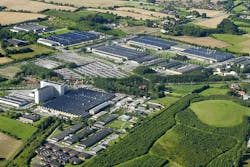Danfoss is a 90-year-old manufacturing leader in three segments: power solutions, climate control, and power electronics and drives. Organic growth, mergers and acquisitions have contributed to our growth. We now have 97 plants in more than 100 countries and are still growing, nearly doubling in size in the past decade alone. As we enjoyed such success, it became increasingly clear that more growth and profitability will require a transformation of our digital landscape across a common backbone. We’ve started that transformation and can share some insights already.
Our first challenge in integrating such a large scope digital transformation project was to get as much attention for manufacturing as ERP, R&D, PLM, CRM and other better-funded functions. When we looked at what it would take to build the kind of digital backbone, we would need to integrate all such functions and it was clear that although manufacturing was the key enabler of such end-to-end integration, it was significantly underfunded.
Given the scope of our mission, it was also clear that smart manufacturing would have an essential role. To us, smart manufacturing is a concept that blends MES/MOM, SCADA, PLCs and OT (operations technology) edge operations.
We began our journey towards digitizing our manufacturing processes in 2019 by setting out our value proposition for implementation across our three segments. In 2020 we got buy-in from all three segments and by 2021 we had consolidated use cases across all segments. Within a year we had gotten approvals on the four workstreams that would become the roadmap for each sector and initiated a pilot for each.
The workstreams involved evaluating business impacts, setting priorities and making organizational, management other changes as needed. These focused on four areas: standardizing MES/MOM platforms, connectivity, OT security and edge OT.
First things first
MES/MOM standardization is a top priority for us. We need a standard backbone that would support all our 97 factories. Each one has a unique manufacturing process, but the core MES functionality would be adapted for each one.
Focusing on connectivity is also a high priority. We must harmonize many different IT landscapes. We need our PLCs and SCADA systems to connect agnostically to the MES layer and we need to transition our acquisitions out of their legacy MES/MOM systems.
OT security is a third focus area. This is increasingly essential for all OT implementations and because smart manufacturing uses the cloud, OT edge application development is our fourth focus.
With so much to do, what do you do first? We started on things that would have the greatest business impact. We build business cases around each and expect ROI within two years.
We have roadmaps in place for all but one segment and are seeing ROI already. Following are some of the business benefits:
- Generation of timely, high-quality data that can be analyzed for business and production optimization.
- Use of no touch processes, which reduces labor costs and improves accuracy.
- Improved productivity of salaried workers to optimize labor costs while improving outcomes.
- Enablement of end-to-end process automation to reduce costs while adding production value.
Lessons learned
Four years into this project, progress may seem slow to some. But we are laying down a foundation that will last us for decades. Following are a few pointers for anyone looking to embark on a similar journey.
- Go for top-down, bottom-up buy-in. Communicating our business proposition to management clearly was critical in getting attention for manufacturing, and we also talked with the operators and supervisors to explain how it would make their jobs easier.
- Find your sweet spot. While you need to think big to pull off a project of this scale, once you get on that track it is easy to get too ambitious. Find the balance between what you’d like to change and what is practical.
- Correct course as needed. Acknowledge that you are on a journey. Reevaluate every step in relation to your business goals.
- Know your strengths and weaknesses. Recognize that you may have to pause, reiterate and restart to take maximum advantage of your talents.
And where you are not strong, be sure that you have a partner network that can fill the gaps. We selected Critical Manufacturing MES to support our smart manufacturing journey, with aims to achieve greater visibility, create transparency, secure IT/OT operations and achieve faster time to market. The Critical Manufacturing MES platform will help standardize operations and processes to improve business process outcomes, compliance and risk management.
Critical Manufacturing works closely with a strong network of certified global partners to ensure customers have access to domain and application experts and are supported throughout their projects.
Center of Excellence
Along with the selection of Critical Manufacturing MES, which is designed for easy multi-site deployment and the ability to embrace technological advancements, continuous process improvement, as well as differences and similarities between sites, having a center of excellence (CoE) is a core element of a successful enterprise-wide MES. A CoE fosters good communication between sites and ensures ongoing coordination, control, maintenance, support and smooth operation of the MES throughout its life.
The CoE defines the global MES roadmap and, as the owner of MES baselines, controls change management. This includes evaluating if requirements should be implemented in MES baselines and approving any changes to the global baselines. The CoE team also coordinates technical implementation, manages priorities between sites and defines the plans for system roll-out. It is responsible for the management of the MES configuration, including deployments and site versions or dependencies.
At the pilot stage, the CoE supports the validation of global requirements, baseline strategies and definition of initial baseline version(s). As the project moves forward, however, the baseline will require further validation and may evolve. It may also require the development of additional baselines to meet different site needs. To ensure local site needs are met, the baseline must contain sufficient flexibility so that the sites will still retain some autonomy in the configuration and utilization of the system.
Successfully navigating a digital transformation project within a global manufacturing company requires a strategic approach and effective communication with your partners. As a result, it is essential to establish clear lines of communication and a shared understanding of project objectives from the outset. We are continuously investing in ongoing support and collaboration mechanisms, such as regular check-ins, workshops and joint problem-solving sessions as we continue our pathway to digitalization and standardization throughout the global Danfoss Group.
Tarun Chopra is head of manufacturing services at Danfoss Group IT.



